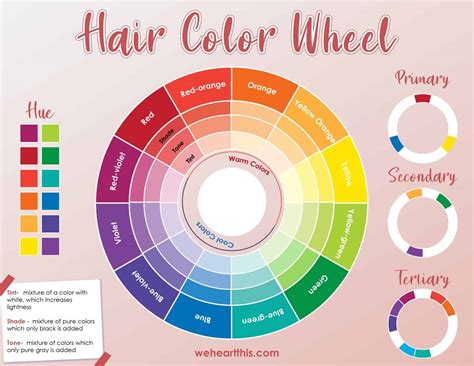Navigating the vast ocean of hair colors can be a daunting task, but with the help of the hair color wheel, you can find a shade that will transform your look and make you shine.

What is the Hair Color Wheel?
The hair color wheel is a color theory tool that organizes different hair colors into a circular diagram. It’s divided into three primary colors (red, yellow, and blue), three secondary colors (orange, green, and purple), and six tertiary colors (yellow-orange, red-orange, red-violet, blue-violet, blue-green, and yellow-green).
How to Use the Hair Color Wheel
1. Determine Your Skin Undertone
The first step is to determine your skin undertone, which can be either warm, cool, or neutral. This will help you narrow down your color choices to those that will complement your skin.
2. Identify Your Base Color
Next, you need to identify your current hair color. The base color is the natural color of your hair before any chemical treatments. If you’re unsure, consult with a professional colorist.
3. Choose Complementary Colors
Once you know your skin undertone and base color, you can start to choose complementary colors from the wheel. Complementary colors are those that are opposite each other on the wheel, such as red and green or blue and orange.
4. Consider Your Personal Style
Finally, it’s important to consider your personal style when choosing a hair color. Do you want a bold, vibrant shade or something more muted and natural? Are you looking for a dramatic change or just a subtle update?
Best Hair Colors for Different Skin Undertones
Warm Undertone
- Golden blonde
- Copper
- Amber
- Honey brown
- Toffee
Cool Undertone
- Ash blonde
- Blue-black
- Platinum
- Burgundy
- Purple
Neutral Undertone
- Any hair color can work with a neutral undertone, but you may prefer shades that have both warm and cool tones.
Popular Hair Color Trends
1. Balayage
Balayage is a freehand painting technique that creates a natural, sun-kissed look. It’s perfect for adding highlights or lowlights to your hair.
2. Ombre
Ombre is a color transition that goes from dark to light or light to dark. It’s a great way to add volume and dimension to your hair.
3. Pastel Colors
Pastel hair colors are a fun and trendy way to add a pop of color to your look. They can be worn by anyone, regardless of skin tone or hair color.
4. Gray Blending
Gray blending is a technique that covers gray hairs while still maintaining a natural look. It’s a great option for people who want to embrace their natural gray hair without dyeing it completely.
How to Maintain Your Hair Color
- Wash your hair with color-safe shampoo and conditioner.
- Use a heat protectant spray when styling your hair.
- Limit the use of heat styling tools.
- Get regular trims to remove split ends.
- Deep condition your hair weekly.
Hair Color Wheel Applications
The hair color wheel can be used for much more than just choosing a new hair color. Here are a few creative ways to use it:
- Create a custom makeup palette by choosing colors that complement your hair color.
- Decorate your home with colors that coordinate with your hair color.
- Design a wardrobe that enhances your hair color.
Benefits of Using the Hair Color Wheel
- Helps you find the perfect hair color for your skin tone and personal style.
- Makes hair color decisions easier and more informed.
- Can inspire new ideas for makeup, home decor, and wardrobe choices.
Conclusion
The hair color wheel is a powerful tool that can help you choose the perfect hair color for your individual needs. By understanding how to use the wheel, you can find a shade that will flatter your skin tone, complement your personal style, and make you feel confident and beautiful.
